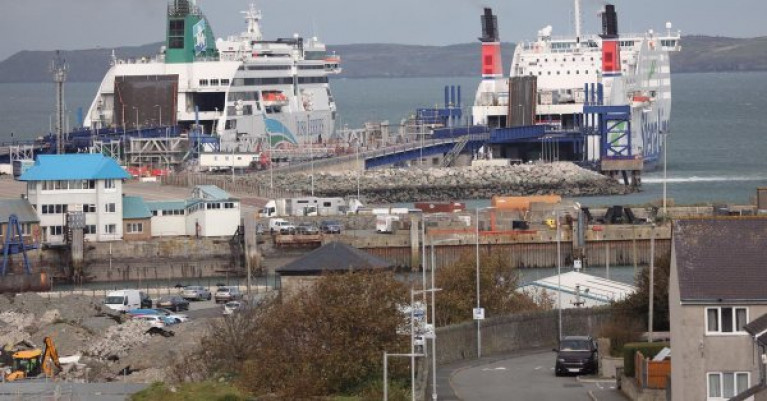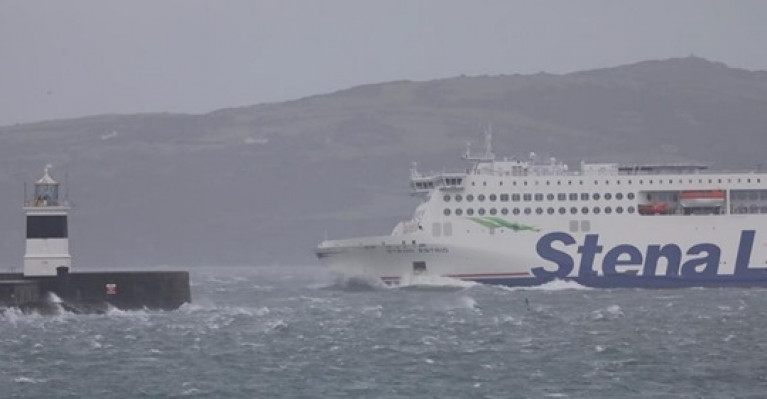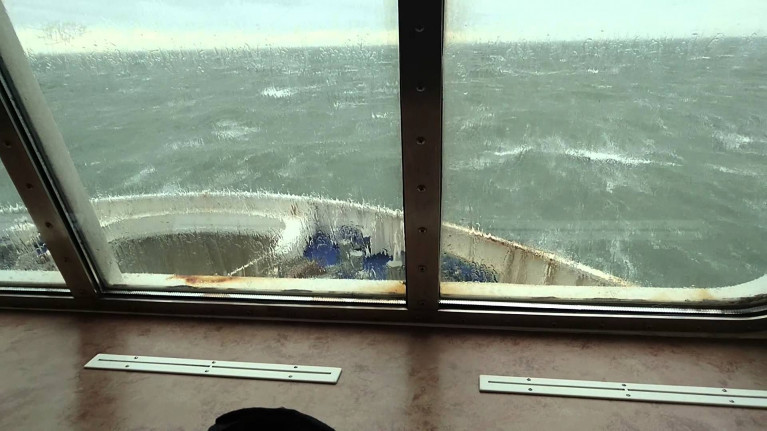Displaying items by tag: Storm Barra
Passengers 'Scared' as Storm Barra Stops Ferries Berthing in Holyhead for More than 14 Hours
For more than 14 hours, two ferries have been stuck off Holyhead as Storm Barra prevented them from docking at the port, as NorthWalesLive reported last night.
The Stena Adventurer and the Ulysses, which is operated by Irish Ferries, sailed from Dublin to Holyhead but were unable to dock on Wednesday due to the weather conditions.
Passengers described the situation on board as some said they felt "scared" and seasick.
For more click here to include passengers from both of the ferries, that had during the sailings posted updates from their twitter accounts.
Stena Ship Circles Dublin Bay Before Arriving in Port While Other Ferries Face Disruption
As Afloat reported this afternoon the impact of Storm Barra on shipping included Stena Estrid which finally entered Dublin Port albeit some 3 and a 1/2 hours late, ironically the same time it takes to sail from Holyhead, writes Jehan Ashmore
When the Wales-Ireland ferry could not enter the port at around 12 noon due to the heavy gusts, Stena Estrid had to ride out the storm during the Orange status weather warning. This led to the ferry head as far off the Co.Wicklow coast before returning to Dublin Bay.
It transpires the ferry did not enter Dublin Port as previously envisaged, has as soon as Afloat reported, the leadship E-flexer class ferry was observed heading back out into Dublin Bay. The ferry then circled around the bay's north and south Burford buoys, before returning again to the north Burford bouy off the Baily Lighthouse to begin finally an inbound sailing
This took place from mid-afternoon, however likewise of fleetmate Stena Adventurer which too was disrupted this morning until tugs arrived to enable a departure, the Stena Estrid had a pair of tugs to assist arrival when berthing in the port.
Note on this occasion of the DPC tug pair, only Beaufort resumed further duties as the second tug required this time involved the Giano. The ASD excort tug is operated by Purple Water Towing with an address in Mary's Abbey, Dublin 7.
Giano handled towing operations on the starboard side of Stena Estrid with Beaufort attended at the stern with moorings in place at the berth conducted around 15.50hrs. Following the exchange between discharge and loading of vehicles and passengers, the ferry is according to the Dublin Port website to depart at 1800hrs.
Noting, Irish Ferries chartered in ropax Epsilon had departed Dublin since 0740hrs, having had sailings cancelled. The ropax though vacated its berth which are at premium in the port and continues to ride out the storm offshore of north Co. Dublin. On the other side of the Irish Sea, Ulysses having previously been reported when sailing to the port in Anglesey, was completed when berthing adjacent to Stena Adventurer.
Another Dublin ferry albeit mostly dedicated to the continental link to Cherbourg, in the form of W.B. Yeats which resumed sailings late last night. The 17-19 hour crossing to France has still yet to be completed with an ETA of 20.00hrs tonight, but not as impacted to the Dublin Bay scene.
The Irish Ferries cruiseferry is fresh from a routine winter dry-docking which took place at the Harland & Wolff Group's Belfast facility.
Storm Barra Batters Dublin Bay with Ships Caught Up in High Seas
As Storm Barra struck Dublin Bay this morning at around 0530hrs, bringing severe and damaging wind gusts as Met Eireann forecast along with issuing a Status Orange warning, a ferry in the capital port would just a few hours later require tug assistance, writes Jehan Ashmore.
The ferry Stena Adventurer when attempting to vacate the berth on a sailing bound for Holyhead, however got into difficulties. This led to the dispatch of Dublin Port Company (DPC) tugs Shackleton and Beaufort to safely bring the ferry temporarily to a nearby quay, albeit on the opposite side facing the river Liffey's northside ferry terminal.
In a statement sought from Afloat, Stena Line cited the reason to call in the tugs was because “the Stena Adventurer (which had) departed this morning on time but on entering the river the vessel was met by very heavy gusts which prevented the ship from leaving the river.
The vessel was then held alongside on the South Bank Berth (46/47) by tugs for a time until there was an appropriate lull in the weather, in accordance with standard safety protocols,and then the ship continued on its journey to Holyhead.”
Ferry Rides Out Storm
Afloat subsequently tracked Stena Adventurer pass the Dublin Bay Buoy just after 10.00 and when bound for Holyhead, from where the outbound Stena Estrid had already departed on schedule from the north Wales port.
Stena Estrid which is the second ferry that serves Stena's Ireland-Wales route however upon arrival into Dublin Bay at around 12 noon, was unable to enter the port. Instead the ferry took a new course from off the North Burford Buoy and soon afterwards Afloat observed the ferry head towards The Muglins beacon lighthouse off Dalkey, marking the south of Dublin Bay.
During lunchtime the Stena Estrid remained off the east coast while offshore between Bray Head and Greystones Harbour before turning around in the opposite direction. The ferry is riding out the storm and is to make another attempt to enter Dublin Port, with the port expecting an arrival of 14.45hrs.
It wasn't just ferries subjected to Storm Barra, as no sooner had the DPC tug twins returned to their recently relocated station, when their services were required yet again and within an hour or so of their brief berthing.
This time it was the Seatruck Ferries ro-ro Seatruck Pace (see previous coverage) which having arrived from Heysham, sought the tugs aid when within the port's shipping fairway. The Shackleton was off the freight-only ferry's bow, while amidships off the port side was Beaufort, a name particularly apt given the stormy seas. The freighter finally berthed at around 11.20, despite the conditions the ship berthed under an hour late of its scheduled arrival.
According to Seatruck's website, however the corresponding return crossing this afternoon to the north-west English port has been cancelled and as well for a fleetmate, Seatruck Progress, whose sailing to Liverpool which was scheduled for earlier this morning.
As of this afternoon Stena Adventurer completed its sailing with an arrival in Holyhead with Irish Ferries Ulysses astern but at time of writing the ferry also from Dublin remains outside the Anglesey port.
Cork's Fastnet Lighthouse Records Gust of 84 Knots as Storm Barra Hits Ireland (Vid)
A number of weather warnings have taken effect across the country, as Storm Barra arrives, bringing gusts in excess of 130km/h.
After making landfall this morning, Storm Barra has caused some flooding in the south and has already left at least 33,000 homes and businesses without power.
The Fastnet lighthouse recorded a gust of 84 knots (155km/h) at 8 am this morning.
A Status Red wind warning for Cork and Kerry has been active from 6 am, while a similar warning for Clare will be in place from 4pm.

In all three counties, wind speeds of over 80 km/h, with severe or damaging gusts in excess of 130km/h, have been forecast by Met Éireann.
A gust of 113 km/h was recorded at around 6 am on Sherkin Island, located just off Cork's coast.
The weather warnings will be in place until 9pm tonight, when these counties will enter a Status Orange wind warning, which will remain in place until 6am tomorrow morning.
Irish Coast Guard Warns of Risks Posed By Storm Barra
The Irish Coast Guard is appealing to all mariners and coastal communities to be mindful of the severe weather warnings and to note the imminent arrival of Storm Barra.
The coastguard is also appealing to anybody considering any form of coastal or open water recreation to be mindful of the risk posed by forecasted Storm conditions.
Walkers are advised to avoid any exposed areas, including seafront and cliff walkways, as they may be hit by sudden gusts, exposing themselves to unnecessary danger.
All other forms of open water recreation should be avoided, including by experienced practitioners, as it may result in arousing public concerns and causing rescue services to be alerted.
A small craft weather warning is already in place and Met Éireann is forecasting that gale to storm force southeasterly winds will extend to all coastal areas from early Tuesday, veering west to northwest in direction later.
As reported earlier on Afloat.ie, winds are forecast to reach Violent Storm Force 11 on Irish coastal waters from West Cork to Galway. The combination of southeasterly winds, spring tides and low pressure provide for an increased risk of localised flooding.
Coastguard operations manager Micheál O’Toole appealed to the public to remain vigilant, to avoid any unnecessary travel and to monitor Met Éireann weather forecasts.
“Remember: stay back, stay high, stay dry. If you see somebody in trouble on the water or on the coast, dial 112 or use marine VHF Channel 16, and ask for the coastguard.”
Minister Urges ‘Safety First’ in Face of Impending Storm Barra
Minister for Agriculture, Food and the Marine, Charlie McConalogue has urged farmers, fishers and people in rural areas to be extra vigilant and take precautions as Storm Barra approaches the country on Tuesday 7 December.
On Monday (6 December), Met Éireann upgraded its previous Status Orange weather warning for Western coastal counties to Status Red for Cork, Kerry and Clare, with gusts of up to 130km/h predicted. The Orange warning has been extended to all Eastern coastal counties as far north as Louth.
In addition, the Status Orange marine warning as been upgraded to Red, with southwesterly winds veering west to northwest expected to increase to Violent Storm Force 11 on Irish coastal waters from Dungarvan to Valentia to Erris Head.
While the exact impact of the storm is yet to be determined, the Department of Agriculture, Food and the Marine says it is “important that sensible steps are taken in advance rather than when it arrives”.
Minister McConalogue said: “I am urging everyone to think safety first as we face into Storm Barra. This is set to be one of the strongest storms we have seen in some time. All life is precious, so we must take all steps to protect ourselves and each other.
“Farming and fishing are exposed more than most to such storms. The fishing fleet is particularly impacted as the force of the storm will be felt most along the Western coastline.
“Fishers should take particular care, heed all weather warnings and ensure vessels are securely berthed in advance of the storm. More generally people should stay back from the shoreline and remain on high ground.”
The department’s public offices in Status Red areas will be closed. For the latest information on areas affected, check the Met Éireann website.
Western Coastal Counties Brace for Impact of Storm Barra This Tuesday
Met Éireann has issued a Status Orange weather warning for counties Cork, Kerry, Limerick, Clare and Galway on Tuesday (7 December) when Storm Barra is forecast to sweep in from the Atlantic.
Southerly winds, later becoming to northwesterly, will reach mean speeds of 65 to 80 km/hr with severe or damaging gusts of up to 130 km/hr. Met Éireann says winds will possibly be higher in coastal areas, and that disruption to power and travel are likely.
“High waves, high tides, heavy rain and storm surge will lead to wave overtopping and a significant possibility of coastal flooding,” the meteorologists warn.
A Status Orange marine warning will also be in effect for 24 hours from midnight tomorrow (Monday 6 December) as southerly winds veering westerly are expected to reach Force 8 to 10 on Irish coastal waters from Mizen Head to Erris Head to Fair Head.


























































